Samplefixtures of a
multifunctional town hall
especially: lighting technique - event technique
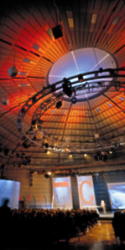 |
Multifunctional usage of the rooms Drastic reduction of fire load Fully automated setup of light- and event technique Infinite extension of the plant without additional installation Computer storage of different events |
|
In modern times a city hall mustn't be prepared for only a few events, but further it has to be a "multifunctional institution". The usage is different today. Success of every single event depends on criteria of equipment. Those fixture characteristics have to be very flexible, because the different events are taking place after each other. Modification times have to be as short as possible. The technical equipment must be functional and cost saving. They have to be extensionable everytime without any large, additional work. The number technical personell should be kept low. A special attention in use of material and technique should be payed for the reduction of fire loads. Those criteria have been specially regarded in planning. The following events have been borne in mind for usage of the hall:
But we all know how praxis has been. With high effort of technique and costs for every single event slight and technique have been installed or leased. Electronical installations has been mounted rough-and-ready. "Wiring harnesses and -trees" were displaced on the floor, the ceiling and the walls under a high effort. Fixing points for sceneries, emblems, banners, etc. had to be created additionally under high effort, because where they were needed there were no possibility to fix it. The present planning shows you solutions to bring light to the right place. Load tractions for stage technique, curtains, sceneries etc. beeing available everywhere in the hall. Recurrent events can be stored through a computer control. Thus stage tractions and illumination equipment atomatically drive to the right position. The hall floor fits to the events requirements. Hall floor The hall floor should be constructed as a false floor (height ca. 600 mm). The false floor with removable slabs ca For most different events ist is necessary to make discussion and interpreter equipment, microfone and monitor connections, slide projectors, etc. available ondifferent places of the hall. A false floor is ideal for that. So-called bottom tanks make it possible to reach all places in the hall with cables in the false floor. 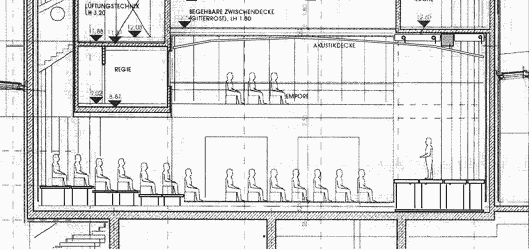 The application of ca. 600 mm allows the use of lift podiums, to customise the hall for the accordant event (lifted chair rows, stage ridges). Through additional platforms even orchestra sceneries or catwalks are possible. Such lift podiums should cover the whole hall, to reduce possible gaps. The single slabs The tractions can be realized through maintanance-free spindle gears. The upstroke is effected by scissors constructions Through this the construction is very flat. The coating is arbitrary. In the different bottom slabs, 60 - 70%, so-called swirl exhausts for the aeration are mounted flush. Thereby it is another advantage of the false floor: Ceiling constructions For the different uses of the hall a flexible ceiling construction has to be created, which allows you to position hoists and spots on every single point. 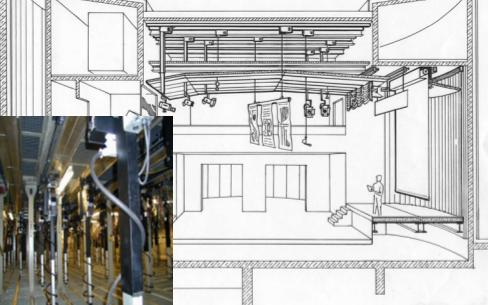 With the application of point hoists the usage becomes variable. Thus single decoration parts like sceneries, spots, emblems, flags or floral decoration can be suspended. The coupling of several point hoists and connections through load rods or fence trusses gives the ability to hang up bigger sceneries or emblems such as curtains. The hoists are moved on special rails. Those rails are so-called load power rails with integral copper lines for power and data transfer.. With this system an additional electonical installation for event technique isn't necessary. Just for rail feed a supply pipe has to be mounted on every end. All plastic parts of this construction are made of non halogen plastic. This combination minimizes the fire load to almost zero. Two application variations are available. First the manual. Motor-hoists and illumination equipment are horizontally moved manual by steerages on which you can walk. Therefore the whole ceiling is inlayed by gratings, to allow the personell to move the single elements easily. 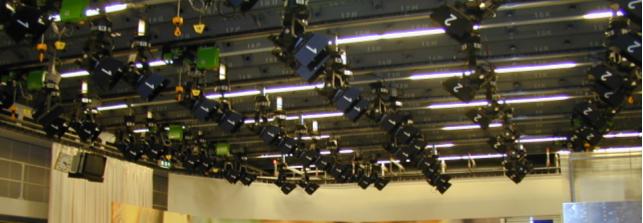 The second variation is the motorized. Elements are moved by a motor. The motor-hoists ropes an and the illuminations pantographs are moved through the steerages. Therefore 10cm-slots in the ceiling are necessary. While tractions and illuminations are not in use they are "parked" in the steerages. Therefore about 1 m ceiling is moved apart ca. 1,5 m the wall. Now equipment can be moved inte the steerages. So in disuse of the technique the ceiling is "cleaned". 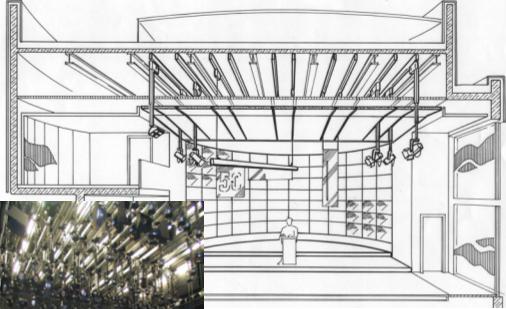 All positions of the hoizontal moveability can be stored and requested every time. Thereby new hall configurations can be created fast, easiliy and without a high amount of personell and time. Another advantage of the system: extensions, additional motored hoists and and illumination equipment can be integrated without any installation effort. We put such a flexible ceiling into operation in december 1998 in the transmission centre of the ORF Brandenburg in Potsdam. A report by an engeneer of the central technique, Mr. Hartmuth Glaser, has been published in the magazine "Medien Bulletin". Illumination The planned illumination is created for event illumination for stage- and show illumination, such as for special illumination. The general illumination hasn't been considered. Level-lense spots between 1000 and 2000 W, with motorized bails are used, so spots can be controled and positioned from the ground every time. The vertical movement is realised by motor driven hoists which are horizontally moved by special rails. This solution allows you to store even light moods and request them in the shortest time, with low amount of personell and time. The requested "mood" is created automatically. The advantage of the system in recurrent events is, that you needn't to calibrate the illumination every single time. The spots are feeded by the mobile dimmer. Thereby an additional installation isn't necassary. The usual dimmer room, such as wasteful electronical installations between dimmer and spots are dropped. Fire load is minimized drastically. All data i stransferd by special contact-conductors lines, which are integrated in the load rails. Through this system spot-units are mounted fast and easily everytime without any amount. Like the hoist, spots can be hidden in the steerages while they are out of use. 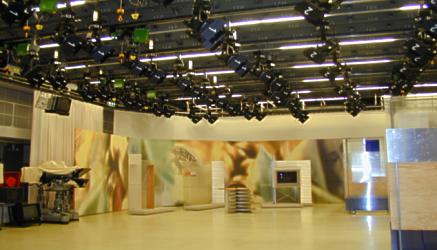 Another advantage of this system solution is the programmability of the whole plant. According to the size the computer lighting moods and motor positions can be displayed and programmed on screen befor. Programs can even be created in home office. Thereby time-consuming test-installations and set-ups are needless. Currently some TV-studios are equipped with this technology. In several studios the Profi-Bus-Control is in use, in others the CAN-Bus-Control is successfully installed. In all studios the light moods are retrievable everytime and the spots are moving full-automatedto there programmed destination. The same for mounted pantographs. With this technology different rooms can be networked. Because of teh network, contingently appearing failures can be found by phone just from the fabricators office and perhaps repared directly from there. The cause of failure can be localised much faster. Operating hour sof illumination equipment and motors can be counted and stored. The technique becomes "predictable". 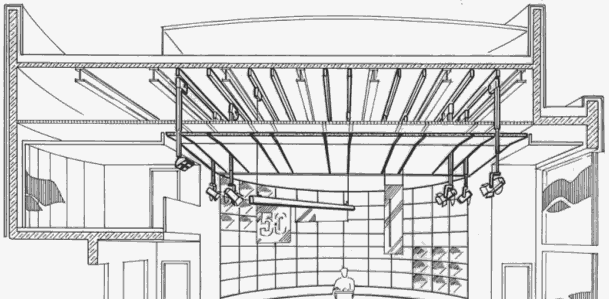 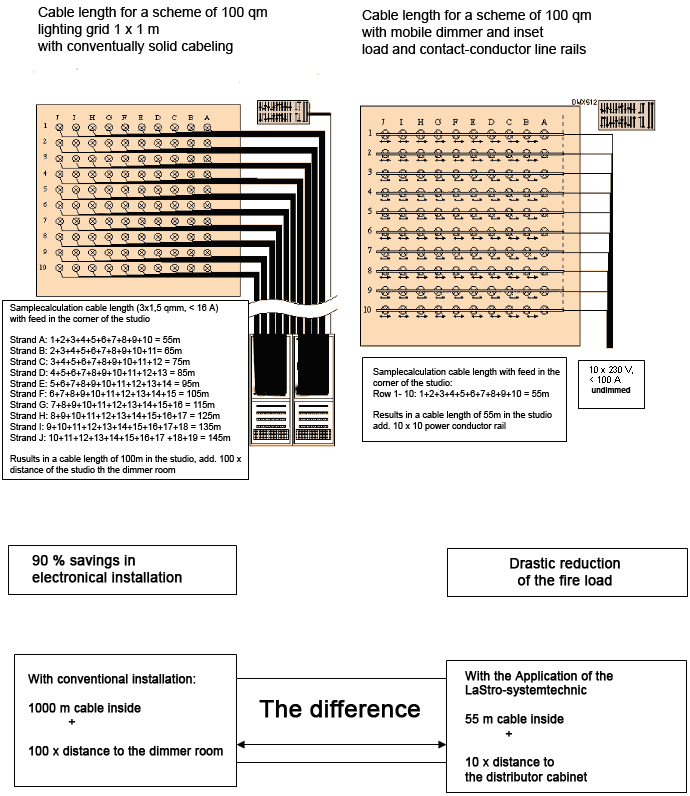 |
LASTRO Engineering GmbH · Martin-Kollar-Straße 9 · D-81829 München · Tel.: +49 (0) 89 - 43 68 91 - 3 · Fax: +49 (0) 2333 - 60 93 37 · E-Mail: lastro@lastro.de